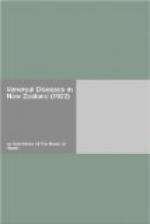It is to be noted that it is recommended that the prophylactic treatment is to be carried out by some properly instructed person. This need not necessarily be a medical man. It is suggested that this form of prophylaxis might be carried out by an orderly at the venereal-disease clinics. The notices posted in the public conveniences and other suitable places indicating the existence of the clinics and the necessity for treatment might include a guarded reference to their use for this purpose.
This form of prophylaxis applies to males. In the case of females the methods adopted would be also contraceptive, and the Committee do not recommend that facilities should be provided for this.
The Committee must not be supposed to advocate prophylaxis as in any way a substitute for continence and the cultivation of that high moral tone that repels any suggestion of promiscuous sexual relationships, but they feel that they could not properly ignore reference to a method of prevention of these diseases which has proved very efficient in the services, to which there appears no reasonable ethical objection, and which brings their prophylaxis into line with that of other infectious diseases.
SECTION 6.—LEGISLATION REQUIRED.
(A.) Conditional Notification.
The only subjects of importance upon which the witnesses examined differed materially in opinion were—(1) whether there ought to be any system of notification of cases of venereal disease, and (2) what steps, if any, should be taken to deal with persons suffering from such disease in a communicable form who refused to be treated, and in some cases were even known to be spreading the disease broadcast. Ladies who attended to give evidence on behalf of the National Council of Women and one or two other women’s organizations objected to notification and compulsory treatment. They argued that there was at present a “scare” on the subject of venereal disease, and deprecated “panic legislation.” They contended that the adoption of notification would deter patients from seeking treatment for fear of publicity. They were opposed to compulsory treatment of recalcitrant patients, arguing that any law of the kind would be used most oppressively against women. They contended that reliance should be placed on greater facilities for free treatment at the clinics, the work of women patrols, suppression of liquor, and above all education and propaganda on moral lines.




